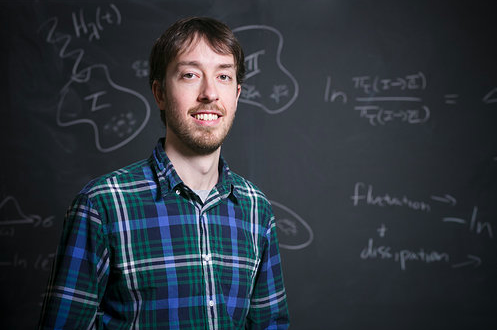 Can physics be the branch of science that finally figures out the origin of life on Earth?
Can physics be the branch of science that finally figures out the origin of life on Earth?
Jeremy England, a professor of physics at the Massachusetts Institute of Technology, is using physics and working to unravel the beginning of life.
Jeremy England was born in Boston and grew up mostly in New Hampshire. After graduating with a degree summa cum laude in Biochemical Sciences from Harvard in 2003, he was a Rhodes Scholar at St Johns College, Oxford for two years before continuing on to complete his doctorate in physics at Stanford in 2009. In 2011, he joined the faculty of MIT’s Physics Department, where he now leads a research team in the Physics of Living Systems group, housed in Tech Square. He lives with his wife and son in Cambridge, Mass.
Life’s Physical Origins
![]()
A scientist’s job is always to propose a model of the world that helps us use one observation to predict and explain another one. For example, when you find a pine-cone on the ground, you probably do not wonder how it got there, since your working model is that things fall to the ground when they are not being held up by something (like a branch or a stem).
In another sense, though, pine trees and other living things like them present us with a puzzle, because all life that we know of seems to be born from things that are already alive. So where did life come from in the first place!?
Science can never tell us for certain what happened in the past, but it does help us to sift through different models of the past, testing how consistent they are with various assumptions and observations we make in the present. In England lab, we model what happens when you take a clump of matter that no one would call alive and then start zapping it with a source of energy (like sunlight) while it is held at constant temperature by a surrounding bath of air or water.
Taking Newton’s Laws as a starting point, we have been able to show mathematically that the clump of matter should rearrange itself over time into more and more specialized shapes that get better and better at absorbing energy from their surroundings. The intriguing and experimentally testable suggestion is therefore that, if we look in the right place, we might be able to observe surprisingly life-like behaviors in objects and materials that we normally think of as being stone dead.
If we succeed in doing so, we still won’t know for sure where life came from, but then again, how do you know how all the pine-cones you see got on the ground, anyway?
Read More: Business Insider: This Physicist Has A Groundbreaking Idea About Why Life Exists

Comments
One response to “Jeremy England, MIT – Life’s Physical Origins”
This idea is not original to Jeremy England. The idea that light hitting atoms can form life was first postulated by me and copyrighted in 2007. Here is a copy paste of the copyright page:
Atomic Memory or Code theory for the Evolution of DNA on Earth.
Type of Work:
Text
Registration Number / Date:
TXu001625307 / 2009-02-11
Application Title:
Atomic Memory or Code theory for the Evolution of DNA on Earth.
Title:
Atomic Memory or Code theory for the Evolution of DNA on Earth.
Description:
Electronic Deposit.
Copyright Claimant:
Christopher Lisle. Address: 1458 Plaza Place, Springdale, AR, 72764.
Date of Creation:
2007
Authorship on Application:
Christopher Lisle; Domicile: United States; Citizenship: United States. Authorship: text
In 2012, my theory was then submitted and accepted for discussion on the theoretical FQXi forum. http://fqxi.org/community/forum/topic/1439
Essay Abstract
This paper posits the idea that DNA on earth originated from a “memory” or “code” embedded in atoms. Although the originations of DNA cannot be proven as of yet, this idea deduces its originations based on what is currently known and can be observed using current technology.
Author Bio